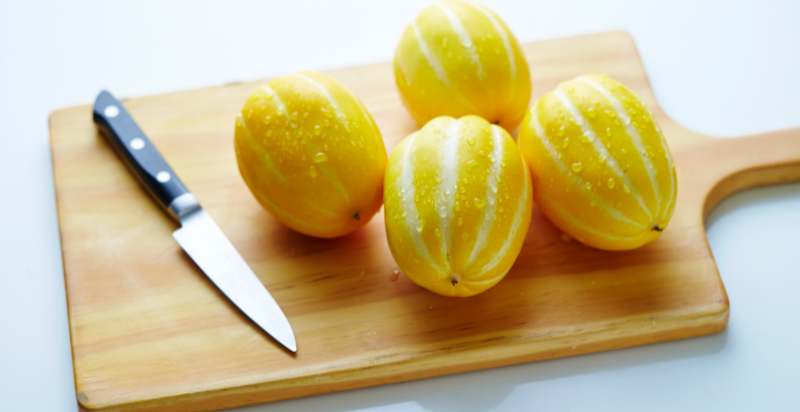Korean melon, also known as chamoe or chamoye, is an incredibly sweet and juicy melon that has become popular worldwide. The unique flavor is described as a combination of honeydew, cantaloupe, and pineapple. Korean melon grows mainly in Korea and Japan but can be found in other parts of Southeast Asia, China, and Europe. Here is a closer look at the melon, its history and cultivation, nutrition, and more.
What is a Korean melon?
Korean melon, known as chamoe in Korean, is a type of cantaloupe grown mainly in the southern regions of Korea. It has a round shape, and its skin ranges from green to yellow. The flesh is sweet and juicy, with an aromatic flavor that stands out among other melons. Its distinct flavor has made it popular for desserts, jams, and savory dishes.
Korean melon is usually eaten raw but can also be cooked in various ways, such as deep-fried, stir-fried, or grilled. One of the popular dishes made with Korean melon is Bbokkum Bbang – a type of pancake filled with sweetened shredded cantaloupe. It is often served as a special snack or appetizer during celebrations and holidays.

History and Origin of Korean Melon
Korean melon is a type of melon native to Korea. The earliest known reference to Korean melons dates back to the late 17th century when it was mentioned in agricultural documents from the Joseon Dynasty. However, the true origin of Korean melons is still unknown, and experts believe that they may be descendants of wild cantaloupe or cucumber-like melons cultivated in the region for centuries.
The Korean melon is widely used in various Korean dishes and desserts, such as bibimbap, fruit tarts, smoothies, juices, sorbets, and more. Its sweet flavor adds a unique twist to many traditional dishes, making it an essential ingredient in Korean cuisine. The popularity of the Korean melon has grown over the years, and it is now available in many places worldwide.
Description of the Korean Melon
Korean melons are oval-shaped fruits with thick, bumpy skin. They range from 10 to 20 centimeters long and 8 to 15 centimeters wide. Their color can vary from deep green to yellow, depending on how ripe they are. The flesh underneath the skin is sweet and juicy with a pleasant aroma. Korean melons have small white seeds and a white inner membrane throughout the flesh. They have a mild flavor that is slightly sweet but not overpowering.
Flavor Profile of Korean Melon
The Korean melon has a sweet taste with an underlying hint of musk. It is juicy and crunchy, providing a refreshing experience in every bite. The aroma is typically fragrant and floral, making it enjoyable to eat. The skin of the melon is thick and firm, which helps preserve its flavor for longer periods. In addition to its sweet flavor, the melon has some subtle notes of honey, mint, and citrus. This makes it a delicious snack for any occasion.
Korean melons are highly versatile and can be used in various ways. They can be eaten as is or added to salads, desserts, snacks, and even beverages. Their sweetness pairs well with yogurt, ice cream, and even cheese. When added to savory dishes, they provide a unique burst of flavor that can help enhance the overall taste of a dish. Many recipes are available online that feature Korean melons as the key ingredient for creating delicious dishes.
Nutrition of Korean Melon
Korean melons are a good source of vitamins A and C and dietary fiber. They are also low in calories and fat, making them an excellent choice for those looking to lose weight or maintain a healthy lifestyle. Additionally, Korean melons contain polyphenols with antioxidant properties that can help protect against cell damage and improve overall health.
Overall, Korean melon is a delicious, highly versatile fruit in the kitchen. It has a sweet flavor that pairs perfectly with other sweet and savory dishes. Furthermore, it is rich in essential nutrients that provide numerous health benefits – making it an ideal snack or ingredient for any meal.
Cultivation of the Korean Melon
The ideal soil temperature for Korean melon germination is 20-25°C, and full sun is necessary. A well-drained sandy loam soil with good organic matter content is best for growing Korean melons. Regular watering (about 1” per week) should be provided during the growing season to ensure optimal growth and development of the fruit.
Fertilization with a balanced fertilizer that contains nitrogen, phosphorous, and potassium is recommended. The melons should be harvested when they reach full size (approximately 10-15 cm in diameter) and are firm. Once picked, the melons have a shelf life of about two weeks at room temperature and can be refrigerated for up to four weeks.
Harvesting of the Korean Melon
Commonly used in Korea, the melon is harvested during late summer and early fall. The harvesting process involves selecting the ripest, healthiest-looking melon from a field. It is then brought to the packing facility, where it undergoes an inspection process where any imperfections are noted and considered before placing it in a box for shipping. After inspection, it is placed in a box of approximately 15-20 cm and sent off to the market. The melon will be sent out immediately after being harvested, usually within two days. Once the melon arrives at its destination, it must be inspected again for quality before distribution.
The process of harvesting Korean melons can take anywhere from 18-30 days, depending on the ripeness of the melon and whether or not it has been organically grown. Farmers must pay close attention to the melons during this time to ensure they are picked at peak quality. If a melon is left on the vine too long, it will become overripe and may lose some flavor and texture.
Where Does Korean Melon Grow?
Korean melons are grown in many parts of the world but are most commonly found in South Korea. The two main areas where Korean melons are grown are Jeju Island and the central region of Gyeonggi-do. Other key production regions include Chungcheongnam-do, Gangwon-do, North Jeolla Province, and South Jeolla Province.
In Jeju Island, the climate is mild and evenly distributed, with high temperatures throughout the year, which makes it an ideal place for growing melons. Some popular varieties in this region are Cheonilyeom, Munchiaegot, and Geumgangsan. Cheonilyeom has a round shape with light green and white stripes. Munchiaegot is smaller than Cheonilyeom and has a light yellow color. Geumgangsan melons have green skin with white lines on them.
Farmers cultivate different varieties of Korean melons, such as Chaehyang, Hanmeuri, and Seochol, in the central region of Gyeonggi-do. Chaehyang is a large melon with light green and white stripes on its skin. Hanmeuri has a yellowish-green color and is medium-sized. Seochol has pinkish-white stripes on it, and its shape resembles an oval.
To get the best quality Korean melons, farmers use various methods for growing them. These include seed selection, soil preparation, and trellising techniques. Farmers also consider the different weather conditions of each region when deciding what varieties to plant and when.
What are the things you need to keep in mind when buying Korean melon?
- Choose a melon with a bright, even color. Look for one that is firm and brightly colored. Avoid those with soft spots or browning around the edges, as these are signs of over-ripeness.
- Smell the melon to check its ripeness. You should be able to get the distinct scent of ripe melon. If there is no smell, or the scent is faint, it’s not yet ripe, and you should look for another one.
- Check for any blemishes on the surface of the melon. While some superficial marks can be found in many melons, large cuts or bruises could indicate that they are overripe or rotten.
- Look for a melon that has a thick stem. This indicates that the melon was harvested at its best ripeness and will have more flavor.
- Give the melon a gentle squeeze — it should have some give but still feel firm overall. If it’s too soft or mushy, it’s not the best choice.
- Choose a heavy melon for its size — this indicates that it contains more juice and will be sweeter.
- A good Korean melon should also have a uniform shape, suggesting it was grown optimally. Avoid odd shapes or lumps, as they may not be as fresh.
These tips will help you select the best Korean melon for your needs! Enjoy!

What is the Best Way to Store Korean Melon?
The best way to store a Korean melon is by wrapping it in a plastic bag and keeping it in the refrigerator. The cold temperature will help slow down or stop the ripening process, allowing you to enjoy your melon for longer periods. You can also place the wrapped melon in the crisper drawer of your fridge for maximum freshness.
If you plan to store the melon for over a few days, it is best to remove it from its plastic bag and wrap it in paper towels or newspaper instead. This will help keep the moisture away from the melon and prevent spoilage. Finally, always check your melon periodically for any signs of spoilage before consuming it.
How to Use Korean Melons in Recipes with Others?
Korean melon can be used in a variety of recipes. Its mildly sweet, juicy flesh can be added to salads for a light and refreshing kick or into smoothies for added natural sweetness. Add Korean melon chunks to your favorite stir-fry dishes or omelets for an interesting flavor twist. Its distinctive taste makes it a great addition to your favorite dessert recipes, such as cakes and sorbets.
If you’re feeling adventurous, why not blend it into kimchi for a unique flavor combination? With some creativity and experimentation, you can find many delightful ways to incorporate Korean melon into your meals.
Finally, remember that the seeds of Korean melon can also be eaten. They have a slightly bitter taste and crunchy texture, adding depth to any dish. You can toast the seeds and add them to salads, stir-fries, grains dishes, or even soups for an extra layer of flavor. So remember to save some of those delicious melon seeds when you’re cutting up your melon.
Conclusion
Korean melon is an incredibly versatile and delicious fruit with various culinary uses. This unique fruit can be enjoyed in many ways, from snacking on its juicy flesh to adding it to your favorite recipes. With the right storage techniques, you can ensure your melon stays fresh and flavorful for weeks. So why try Korean melon and see how it adds some new life to your meals? Enjoy!
- Everything You Wanted to Know About Red Tamarillos - June 2, 2025
- A Guide to Tulips: Everything You Need to Know & More… - June 2, 2025
- Guanabana: Description, Flavor, Benefits, And Uses - May 27, 2025

2 thoughts on “Korean Melon: Taste, Benefits And Uses”
Comments are closed.